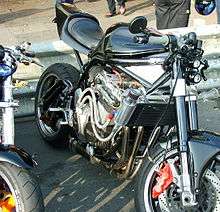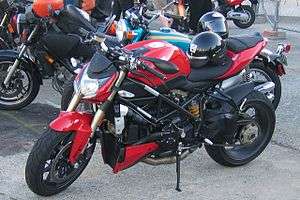Streetfighter
A streetfighter is a sport bike that is customized by removing the fairing, and making other changes that result in an overall more aggressive look.[1][2] Beyond simply removing fairings, specific changes that exemplify the streetfighter look are a pair of large, round headlights, tall, upright handlebars such as those on a motocross bike, and short, loud, lightweight silencers. Streetfighters is also the name of a UK motorcycle magazine.[3]

Later streetfighters used custom-built frames intended to overcome the weakness of the tubular steel frames of the early 4-cylinder superbikes of the 1970s and 1980s. Many of these frames turned out to be "beautifully crafted pieces of metallurgical art," perhaps only unintentionally.[4] Many were also originally racing machines.[5]
Made popular by European riders,[6] this type of custom motorcycle gained worldwide popularity, and motorcycle manufacturers responded in the late 1990s by adopting the terminology[7] and producing factory-built streetfighters, beginning with the 1994 Triumph Speed Triple[8] and the 1999 Honda X11,[9] up through the 2009 Ducati Streetfighter.

History
Though it has its styling roots in the café racer culture of the 1950s and 1960s, the streetfighter is very much inspired by the new Japanese bikes of the late 1970s and early 1980s,[10] possibly from young riders in the UK who couldn't afford to replace damaged fairings after repeated crashes. Later, more appropriate headlights were added, then high handlebars to aid in wheelies and other stunts.[11][12]
The first sighting of the streetfighter design template was seen in Bike magazine in 1983 when the editor commissioned Andy Sparrow to draw a comic strip to replace Ogri. It was titled Bloodrunners and featured dispatch riders, delivering blood and live human organs for transplant operations in which bikers rode enormous Japanese inline fours with turbos, with no extraneous parts. Fairings, mirrors, pillion seats & rear footpegs etc. were all binned (removed) in favour of lightness and handling ability. Under-seat exhausts, dual headlights and the widest sport tyres were de-rigueur.
Actor Huggy Leaver is credited with being inspired to build such customized motorcycles in this style and there was a proliferation of 'ratted' streetfighters in London around the late 1980s. The term streetfighter was first applied to a custom street bike by a British photojournalist and bike builder to a Harley-Davidson customized sports-bike, and later extended to the Japanese four-cylinder customs being created at the time.[13]
References
- Wallis, Michael; Clark, Marian (2004), Hogs on 66: Best Feed and Hangouts for Road Trips on Route 66, Council Oak Books, ISBN 978-1-57178-140-6,
Streetfighter -- Also known as a 'hooligan' cycle, this is a sports-bike stripped of all superfluous bodywork.
- Doeden, Matt; Leonard, Joe (2007), Choppers, Lerner Publications, ISBN 978-0-8225-7288-6,
streetfighter: a type of superbike customized for maximum speed and performance.
- Streetfighters, WorldCat, ISSN 0961-9453
- Seate, Mike (2007), How to Build a Pro Streetbike, MBI Publishing Company, pp. 92–3 ff, ISBN 978-0-7603-2450-9,
[In London in the early 1990s,] I noticed an odd-looking motorcycle idling loudly across the crowded intersection. The bike's upside-down front end was topped by a pair of oversized headlights that appeared to have been stolen from a car. The rider's gloved hands clutched a set of what looked like handlebars from a motocross bike, while the exhaust can -- or what little remained of it -- was burbling like a beehive on fire.
Was this a prop from Mel Gibson's Road Warrior? Some poor motorcycle courier who had dropped his machine so many times that he'd refused to replace his damaged fairing? [more] - Caught naked by A Cathcart - Motorcycle Sport and Leisure, 2002
- Motorcycling for Dummies - Page 69. Bill Kresnak. 2008
- Categorization bases and their influence on product category knowledge structures. JA Rosa, JF Porac - Psychology and Marketing, 2002
- Brooke, A. Lindsay (2002), Triumph motorcycles: a century of passion and power, MotorBooks/MBI Publishing Company, p. 160, ISBN 978-0-7603-0456-3
- de Cet, Mirco (2002), The illustrated directory of motorcycles, MotorBooks/MBI Publishing Company, p. 214, ISBN 978-0-7603-1417-3
- Street Bikes by R Eagen 2007
- Inman, Gary (June 2008), "Freedom Fighter; Triumph's stripped-down sportbike came from the street", Cycle World, pp. 36–7, ISSN 0011-4286,
The origins of the species are disputed. Some say that the Germans put high-bar conversions on sportbikes to lessen the soft tissue damage of the annual high-mileage pilgrimage to the Isle of Man for the TT races, and these were the first streetfighters. Others say -- and I agree -- that young British GSX-R riders removed their bike' fairings after crashes. They were already up to their Simpson Bandits debt to buy the bikes; they still owed three years of payments and dared not claim on the insurance for fear of having their policies loaded to the point they were priced off the road. The situation wasn't helped by the Japanese firms' replacement-parts pricing structure making new bodywork out of the question. And the old oil-cooled Gixxer Four is just about the best looking Japanese motorcycle ever, so why not show it off?
- Seate, Mike (2007), How to Build a Pro Streetbike, MBI Publishing Company, p. 95, ISBN 978-0-7603-2450-9,
...examples of the style began showing up almost by accident (pardon the pun) on the stunt riding scene early on. Just as many European riders had crafted naked bikes out of crash-damaged sportbikes, many American freestyle riders simply came to the conclusion that their CBR 900RR would ride better on one wheel with the fairing removed, the clip-ons traded for a set of tubular bars, and a custom bent exhaust pipe that didn't scrape on the pavement during wheelies.
- Inman, Gary (June 2008), "Freedom Fighter; Triumph's stripped-down sports-bike came from the street", Cycle World, p. 37,
While the exact genesis of the breed may be up for interpretation, the first use of the evocative name of these bikes is not: My friend Clink coined it. This British photojournalist and serial bike builder used it first to describe a Harley. A hot-rodded Harley custom that used sportbike suspension and eschewed the chrome and engraving of the day for powder-coating and motorsport finishes. Clink also noticed the groundswell of Japanese custom sports-bikes being built, mainly in the north of England, that would be described as streetfighters. He is related to these bikes in the same way Tom Wolfe is to Kandy-Kolored Tangerine Flake Streamline Babies.
External links
| Wikimedia Commons has media related to Streetfighter (motorcycle). |